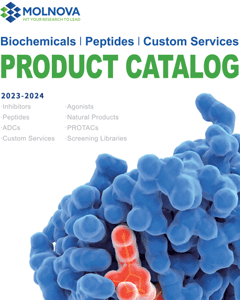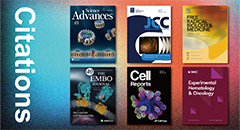
Delafloxacin
CAS No. 189279-58-1
Delafloxacin( RX-3341 | WQ-3034 | ABT492 )
Catalog No. M17400 CAS No. 189279-58-1
Delafloxacin (RX-3341, ABT-492) is a fluoroquinolone antibiotic agent. It has potent inhibitory against levofloxacin-resistant Streptococcus pneumoniae strains (MIC: 0.0078-0.125 μg/ml).
Purity : >98% (HPLC)
 COA
COA
 Datasheet
Datasheet
 HNMR
HNMR
 HPLC
HPLC
 MSDS
MSDS
 Handing Instructions
Handing Instructions
| Size | Price / USD | Stock | Quantity |
| 10MG | 35 | In Stock |


|
| 25MG | 72 | In Stock |


|
| 50MG | 138 | In Stock |


|
| 100MG | 219 | In Stock |


|
| 200MG | 325 | In Stock |


|
| 500MG | 529 | In Stock |


|
| 1G | Get Quote | In Stock |


|
Biological Information
-
Product NameDelafloxacin
-
NoteResearch use only, not for human use.
-
Brief DescriptionDelafloxacin (RX-3341, ABT-492) is a fluoroquinolone antibiotic agent. It has potent inhibitory against levofloxacin-resistant Streptococcus pneumoniae strains (MIC: 0.0078-0.125 μg/ml).
-
DescriptionDelafloxacin (RX-3341, ABT-492) is a fluoroquinolone antibiotic agent. It has potent inhibitory against levofloxacin-resistant Streptococcus pneumoniae strains (MIC: 0.0078-0.125 μg/ml).
-
In Vitro——
-
In VivoDelafloxacin (the total daily doses vary from 0.156 to 640 mg/kg/24 h, subcutaneous injection) is highly effective against S. aureus. Against all four strains are observed a decrease of 1.5 to 2.2 log10 CFU in organism burden from untreated controls at even the lowest dose studied, and for two strains (MW2 and R2527) there is net bactericidal activity at the lowest dose. At the maximal doses studied, there is a >4-log10 kill from initial burden for all S. aureus strains.Delafloxacin (2.5, 10, 40, and 160 mg/kg; subcutaneous injection, 24 h) has moderate terminal elimination half-life (t1/2=0.68 h, 0.79 h, 0.69 h and 1.0 h for 2.5 mg/kg, 10 mg/kg, 40 mg/kg, and 160 mg/kg, respectively). Animal Model:Mice with a neutropenic murine lung infection model (fourS. aureus , four S. pneumoniae, and fourK. pneumoniae strains)Dosage:The total daily doses vary from 0.156 to 640 mg/kg/24 h Administration: 0.03 to 160 mg/kg are administered every 6 h (q6h) to infected mice by subcutaneous injection Result:Inhibited S. aureus strains ATCC 29213, ATCC 33591, MW2, R2527 with MICs of 0.008, 0.008, 0.004, and 0.004 mg/L, respectively.Inhibited S. pneumoniae strains ATCC 10813, ATCC 49619, 145, and 1329 with MICs of 0.03, 0.125, 0.016, and 0.016 mg/L, respectively.Inhibited K. pneumonia strains ATCC 43816, 4105, 4110, and 81-1260A with MICs of 0.06, 1, 0.5, and 0.06 mg/L, respectively.Animal Model:Neutropenic mice Dosage:2.5, 10, 40, and 160 mg/kg; 0.2 mL Administration:Subcutaneous injection; 24 h Result:The maximum drug concentrations (Cmax) concentrations ranged from 2 to 71 mg/L. AUC0-∞ values ranged from 2.8 to 152 mg?h/L and were linear across the 2.5- to 160-mg dosing range. The elimination half-life (t1/2) ranged from 0.7 to 1 h.
-
SynonymsRX-3341 | WQ-3034 | ABT492
-
PathwayWnt/Notch/Hedgehog
-
TargetWnt/beta/catenin
-
RecptorBacterial
-
Research AreaInfection
-
Indication——
Chemical Information
-
CAS Number189279-58-1
-
Formula Weight440.76
-
Molecular FormulaC18H12ClF3N4O4
-
Purity>98% (HPLC)
-
SolubilityIn Vitro:?DMSO : 100 mg/mL (226.88 mM)
-
SMILESC1C(CN1c1c(cc2c(c1Cl)n(cc(c2=O)C(=O)O)c1nc(c(cc1F)F)N)F)O
-
Chemical Name——
Shipping & Storage Information
-
Storage(-20℃)
-
ShippingWith Ice Pack
-
Stability≥ 2 years
Reference
1. Gunderson SM, Hayes RA, Quinn JP, Antimicrob Agents Chemother. 2004 Jan;48(1):203-8.
molnova catalog



related products
-
TNIK-IN-7
TNIK-IN-7 is a potent and selective Traf2 and Nck interacting kinase (TNIK) inhibitor (IC50: 11 nM) with antitumor activity for studying signaling and proliferation in colorectal cancer cells.
-
Wnt pathway activato...
Wnt pathway activator 1 is a potent Wnt activator with an IC50 of 28-29 nM. Wnt pathway activator 1 is a potent Wnt activator for the treatment of androgenetic alopecia (AGA) extracted from patent WO2012024404A1.
-
Cardiogenol C hydroc...
Cardiogenol C hydrochloride can induces the differentiation of ESCs into cardiomyocytes (EC50= 100 nM).



 Cart
Cart
 sales@molnova.com
sales@molnova.com


